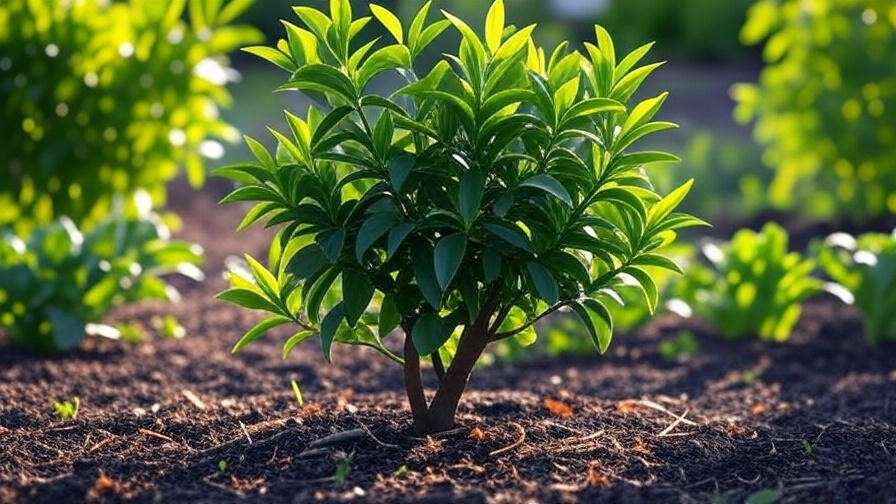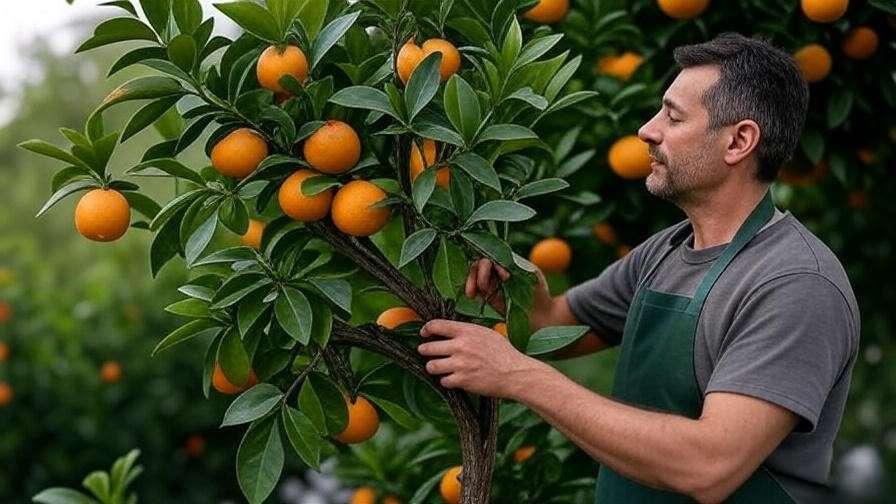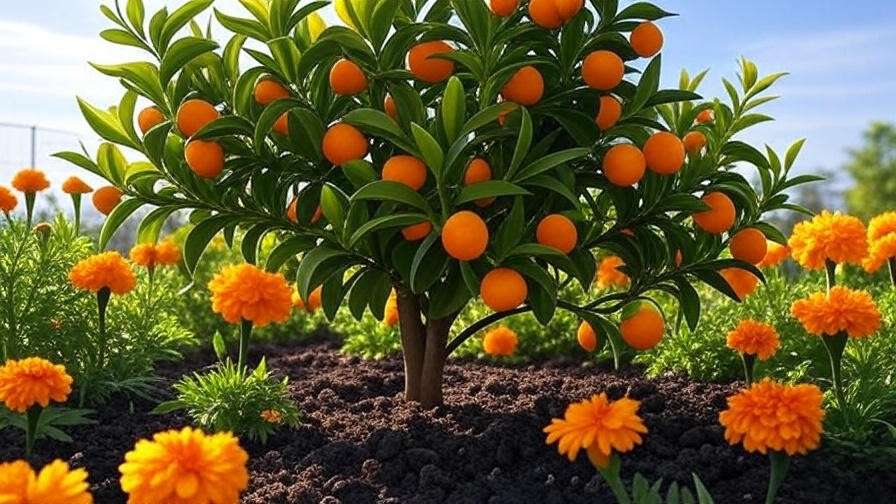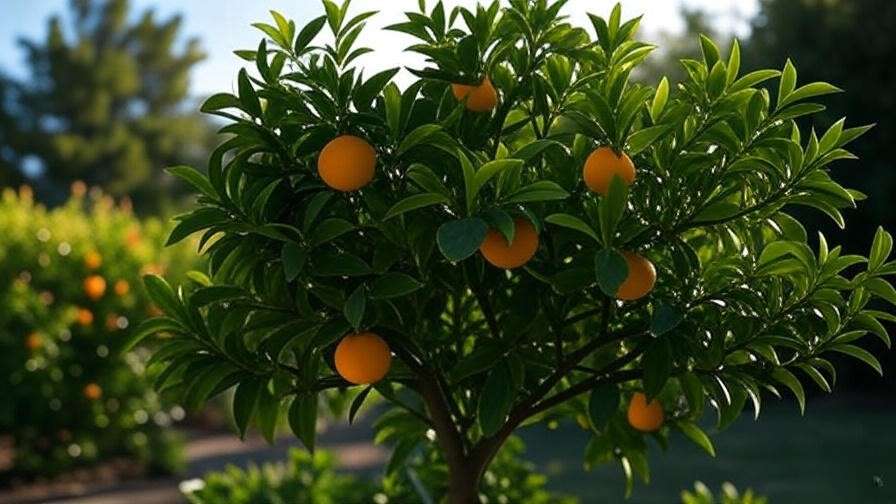Imagine stepping into your backyard to pick juicy, sweet oranges from your very own Hamlin orange tree, bursting with flavor and ready for juicing or snacking! 🌞 The Hamlin orange tree, a beloved citrus variety, is a fantastic choice for home gardeners and orchard enthusiasts alike, thanks to its early-season harvests, cold tolerance, and versatility. Whether you’re a beginner or a seasoned grower, this comprehensive guide will walk you through every step to cultivate a thriving Hamlin orange tree. From planting to pest control, we’ll cover expert-backed tips to ensure abundant harvests. 🍊 Let’s dive into the world of citrus care and transform your garden into a citrus paradise! 🌳
What Makes the Hamlin Orange Tree Special? 🍊
Overview of the Hamlin Orange Tree
The Hamlin orange tree, originating in Florida in the late 19th century, is a leading citrus variety prized for its early ripening fruit, typically ready from October to January. 📜 This seedless orange is known for its thin, smooth skin and juicy, mildly sweet flesh, making it a top choice for fresh-squeezed juice. 🍹 Its compact size and adaptability make it ideal for both home gardens and commercial orchards. According to the University of Florida’s Institute of Food and Agricultural Sciences (IFAS), Hamlin accounts for a significant portion of Florida’s orange juice production due to its high juice content and reliability.
Benefits of Growing a Hamlin Orange Tree
Growing a Hamlin orange tree offers more than just delicious fruit. 🍊 Oranges are packed with vitamin C, fiber, and antioxidants, supporting a healthy diet. 🥗 The tree’s lush green foliage and vibrant oranges add aesthetic appeal to any garden, creating a tropical vibe. 🌿 Plus, Hamlin oranges are versatile—perfect for juicing, snacking, or adding zest to recipes. For gardeners, the tree’s cold-hardiness (surviving brief dips to 25°F) makes it a resilient choice for various climates, especially in USDA zones 9–11.
Choosing the Right Hamlin Orange Tree 🌱
Selecting a Healthy Tree
To set your Hamlin orange tree up for success, start with a healthy specimen. Purchase from reputable nurseries or online suppliers offering certified disease-free stock, as citrus greening (HLB) is a major concern. 🏬 Look for trees with vibrant green leaves, a strong root system, and no signs of pests or yellowing. Dwarf varieties (8–10 feet tall) are perfect for small spaces or container gardening, while standard trees (15–20 feet) suit larger yards or orchards. 🌳 A healthy tree ensures better growth and fruit production, so inspect carefully before buying. 👀
Best Climate and Location
Hamlin orange trees thrive in USDA zones 9–11, where winters are mild, but they can be grown in cooler regions with proper care, such as container gardening or frost protection. ❄️ These trees need full sun—6 to 8 hours daily—to produce abundant fruit. ☀️ Choose a well-draining site with slightly acidic soil (pH 6.0–7.0), as citrus roots are sensitive to waterlogging. Test your soil with a pH kit, available at garden centers, to ensure optimal conditions. 🌍 Avoid low-lying areas where cold air settles, as this can harm your tree.
Planting Your Hamlin Orange Tree Step-by-Step 🌱
When and Where to Plant
Timing is key for planting a Hamlin orange tree. Spring or early fall is ideal, allowing roots to establish before extreme heat or cold. 🌸 Select a site with good drainage and ample sunlight, spaced 12–15 feet apart for standard trees or 8–10 feet for dwarfs to prevent overcrowding. 📏 Avoid areas prone to frost pockets or heavy clay soils that retain water, as these can lead to root rot. 🚫💧 A well-chosen spot sets the foundation for a healthy, productive tree.

Planting Process
- Dig the Hole: Create a hole twice as wide and as deep as the root ball to give roots room to spread. ⛏️
- Amend the Soil: Mix native soil with compost or organic matter (like aged manure) to boost nutrients and drainage. 🌾
- Position the Tree: Place the tree so the root crown sits slightly above ground level to prevent rot. Gently spread the roots. 🌱
- Backfill and Water: Fill the hole, tamp down lightly, and water thoroughly to settle the soil. 💦
- Mulch: Apply a 2–3-inch layer of organic mulch (e.g., wood chips) around the base, keeping it 4 inches from the trunk to avoid rot. 🌿
Expert Tip: Water deeply after planting and check soil moisture daily for the first week to ensure proper root establishment. 🚫
Essential Care Tips for a Thriving Hamlin Orange Tree 🌿
Watering Requirements
Consistent watering is crucial for Hamlin orange trees, especially during their first two years. 💧 Young trees need deep watering 1–2 times per week, delivering about 1–2 inches of water, depending on rainfall. Established trees can tolerate less frequent watering but still require consistent moisture. Use a soaker hose or drip irrigation for efficient delivery. 💦 Watch for signs of overwatering (yellowing leaves, soggy soil) or underwatering (wilting, dry soil). Adjust based on weather—less in rainy seasons, more during droughts. ⚠️

Fertilizing for Optimal Growth
Fertilizing fuels healthy growth and bountiful harvests. Use a citrus-specific fertilizer (e.g., 10-10-10 or 8-8-8) rich in nitrogen, phosphorus, and potassium, plus micronutrients like zinc and magnesium. 🌾 Apply every 6–8 weeks during the growing season (spring to summer), following package instructions for dosage. For a 3-year-old tree, about 1–2 pounds of fertilizer spread evenly around the drip line is typical. Avoid over-fertilizing, which can burn roots. 📅 Expert Insight: Foliar sprays with micronutrients can address deficiencies quickly, especially if leaves show yellowing. 🔬
Pruning and Maintenance
Pruning keeps your Hamlin orange tree healthy and productive. ✂️ Prune in late winter or early spring before new growth begins. Remove dead, damaged, or crossing branches to improve airflow and sunlight penetration. 🌬️ Thin out crowded areas to reduce disease risk. Regularly remove suckers (shoots below the graft line) and water sprouts, as they sap energy. Mulch annually to suppress weeds and retain moisture, and keep the base clear of debris to deter pests. 🧹 Regular maintenance ensures a tidy, vigorous tree.

Protecting Your Hamlin Orange Tree from Pests and Diseases 🐞
Common Pests
Hamlin orange trees, like all citrus, can attract pests that threaten their health. 🕷️ Common culprits include citrus leaf miners, aphids, and scale insects. Citrus leaf miners create serpentine trails in leaves, weakening young trees. Aphids suck sap and transmit viruses, while scale insects form crusty patches on stems and leaves. For organic control, use neem oil or insecticidal soap, applied early in the morning or late evening to avoid leaf burn. 🌿 Pro Tip: Introduce beneficial insects like ladybugs or lacewings, which naturally prey on aphids and scales, creating a balanced ecosystem in your garden. 🐞 Regular inspections—checking the undersides of leaves and stems—help catch infestations early.
Common Diseases
Citrus greening (Huanglongbing or HLB) is a devastating bacterial disease spread by the Asian citrus psyllid. 🚨 Symptoms include yellowing leaves, misshapen fruit, and bitter taste. While there’s no cure, prevention is key: purchase disease-free trees, monitor for psyllids, and remove infected branches promptly. Root rot, caused by overwatering or poor drainage, leads to wilting and decay. Ensure proper soil drainage and avoid overwatering to prevent it. 🩺 Citrus canker, marked by lesions on leaves and fruit, can be managed by removing affected parts and applying copper-based fungicides. Expert Advice: Sanitize pruning tools with a 10% bleach solution between cuts to prevent disease spread. 🧼
Cold Protection
Hamlin orange trees are cold-hardy for citrus, tolerating brief dips to 25°F, but prolonged frost can damage them. ❄️ For young trees, wrap trunks with burlap or frost cloth during cold snaps. For potted trees, move them indoors or to a sheltered area when temperatures drop below 30°F. 🌡️ Established trees benefit from a thick mulch layer to insulate roots. If frost is forecast, water the soil lightly beforehand to retain heat. Stringing holiday lights (non-LED) around the canopy can provide gentle warmth. Consistent winter care keeps your tree safe through chilly months.

Harvesting and Enjoying Your Hamlin Oranges 🍊
When to Harvest
Timing your harvest ensures the sweetest, juiciest Hamlin oranges. 🍊 Fruit typically ripens between October and January, depending on your climate. Look for a bright, uniform orange color and a slight give when gently squeezed. Unlike some fruits, oranges don’t ripen further after picking, so test one for flavor before harvesting the batch. 😋 Tip: If the fruit tastes tart, leave it on the tree for another week or two to develop sweetness, as early picking is a common cause of sour oranges.
How to Harvest
Harvest with care to avoid damaging your tree or fruit. ✂️ Use clean, sharp pruning shears to cut the stem about 1/4 inch above the fruit, preventing tears that could invite pests. Avoid pulling fruit, as this can harm branches. Store harvested oranges at room temperature for 1–2 weeks or refrigerate for up to a month to maintain freshness. 🧊 Sort through your haul and use any blemished fruit first for juicing or cooking to minimize waste.
Uses for Hamlin Oranges
Hamlin oranges shine in a variety of uses. 🍹 Their high juice content makes them perfect for fresh-squeezed orange juice or smoothies. Add segments to salads for a citrusy burst or use the zest in baking for cakes, muffins, or cookies. 🥧 Recipe Idea: Try a simple Hamlin orange vinaigrette—mix 1/4 cup fresh Hamlin orange juice, 2 tablespoons olive oil, 1 tablespoon honey, and a pinch of salt for a refreshing salad dressing. 🥗 You can also make marmalade or candied peels for a sweet treat. These versatile oranges elevate both sweet and savory dishes.

Troubleshooting Common Hamlin Orange Tree Problems ⚠️
Yellowing Leaves
Yellowing leaves are a common issue with Hamlin orange trees, often signaling nutrient deficiencies, overwatering, or pest damage. 🟡 Nitrogen or magnesium deficiencies cause yellowing between veins; apply a citrus-specific fertilizer or Epsom salts (magnesium sulfate) to correct this. Overwatering leads to soggy roots—check soil moisture and reduce watering if needed. Pests like spider mites can also cause yellowing; inspect leaves and treat with neem oil if necessary. Solution: Conduct a soil test (kits available at garden centers) to pinpoint deficiencies and adjust care accordingly. 🧪
Low Fruit Yield
A disappointing harvest can result from poor pollination, nutrient imbalances, or improper pruning. 🍊 Ensure bees and other pollinators have access to your tree by avoiding broad-spectrum pesticides during bloom. 🐝 Over-pruning can remove fruiting wood, so focus on light, strategic cuts. Nutrient imbalances, especially low potassium, reduce fruit set—use a balanced fertilizer with adequate potassium. Fix: Hand-pollinate with a small brush if pollinators are scarce, and maintain consistent care to encourage flowering and fruiting.
Dropping Fruit
Premature fruit drop is frustrating but often fixable. 🍂 Water stress—either too much or too little—can cause fruit to drop; maintain consistent soil moisture with a soaker hose. Nutrient deficiencies or hormonal imbalances during fruit set can also contribute. Natural thinning, where the tree sheds excess fruit, is normal in heavy bloom years. Remedy: Monitor environmental conditions, ensure proper fertilization, and avoid drastic changes in watering to stabilize fruit retention. 🌡️
Expert Tips for Long-Term Success 🌟
- Companion Planting: Plant marigolds or nasturtiums near your Hamlin orange tree to repel pests like aphids and whiteflies. 🌼 These companions also attract pollinators, boosting fruit production.
- Soil Health: Add compost or organic matter annually to maintain soil fertility. A 2–3-inch mulch layer conserves moisture and suppresses weeds. 🌾
- Monitoring: Use a gardening app or journal to track watering, fertilizing, and pruning schedules. This helps identify patterns and optimize care. 📱
- Case Study: A Florida gardener, Jane S., transformed her backyard into a thriving citrus grove by planting dwarf Hamlin orange trees in raised beds with drip irrigation. Her consistent care—weekly watering, monthly fertilizing, and organic pest control—yielded 50 pounds of oranges per tree annually. 🏡

Frequently Asked Questions (FAQs) ❓
- Q1: How long does it take for a Hamlin orange tree to bear fruit?
A: Grafted trees typically produce fruit in 2–3 years, while seed-grown trees take 5–7 years. Proper care speeds up this timeline. 🌳 - Q2: Can I grow a Hamlin orange tree in a pot?
A: Yes, dwarf Hamlin varieties thrive in large containers (15–20 gallons) with well-draining soil and regular care. 🪴 - Q3: How do I protect my tree from citrus greening?
A: Start with certified disease-free stock, monitor for psyllids, and maintain tree vigor through proper nutrition and watering. 🩺 - Q4: Why are my Hamlin oranges sour?
A: Sour fruit is often due to early harvesting. Wait for full ripening (bright orange color and slight give) for optimal sweetness. 🍊
Conclusion
Growing a thriving Hamlin orange tree is a rewarding journey that brings delicious, homegrown citrus to your table. 🍊 By choosing a healthy tree, planting it correctly, and providing consistent care—watering, fertilizing, pruning, and pest management—you’ll enjoy abundant harvests for years. Start your citrus adventure today and share your progress with our gardening community! 🌱 With these expert tips, your Hamlin orange tree will flourish, delivering juicy, sweet oranges that elevate your meals and brighten your garden. 🌟













